Go to Mozambique bird tours | Zimbabwe bird tours | African trip reports | All our Birding Tours
20 NOVEMBER – 5 DECEMBER 2021
By Dylan Vasapolli
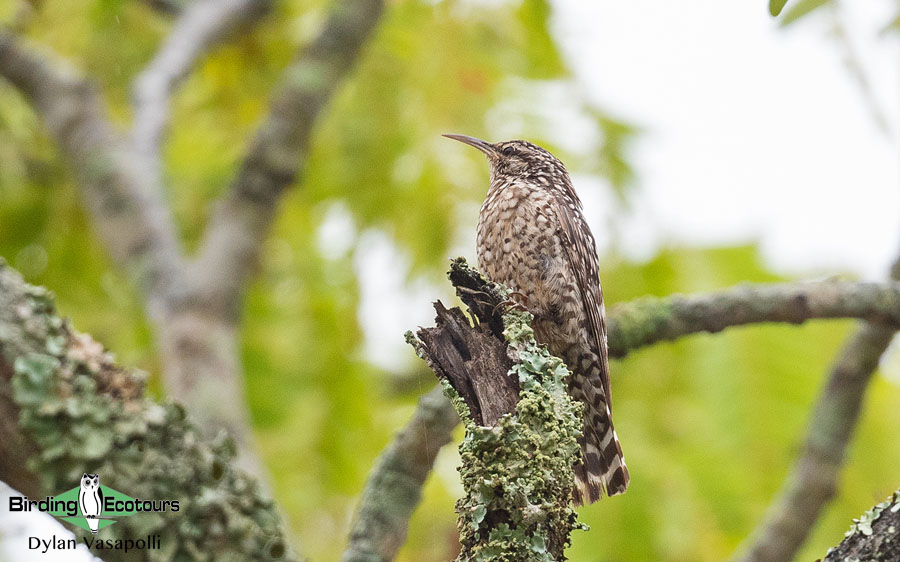
Overview
This set departure tour was set up and timed specifically to maximize chances at finding one of Africa’s most sought-after birds, the African Pitta. This scarce and nomadic species usually move into the area following the onset of the rainy season and begin displaying – giving birders a small window to see this enigmatic bird. Once paired up and nesting, the birds become very secretive and are difficult to find. As an aside to the pitta, we also search for many specials of the lowland forest region of southeast Africa. These are also of particular importance as the area of central Mozambique south of the Zambezi River, which this area falls squarely within, also counts to the Southern African subregion which has a dedicated listing group.
Birding Ecotours usually runs a Zimbabwe and Mozambique tour, that focuses on finding African Pitta, along with a host of other localized and sought-after species found in the two countries, but the ongoing Covid-19 pandemic has made cross-border tours specifically difficult, and this particular routing impossible with the land border between these two neighboring countries closed. Therefore, we opted to run a Mozambique-only tour, which would see us targeting African Pitta and the other central Mozambique specials, along with heading into the remote highlands of western Mozambique – which are contiguous with the Zimbabwe ‘Eastern Highlands’, and host the same suite of miombo woodland and montane forest specials.
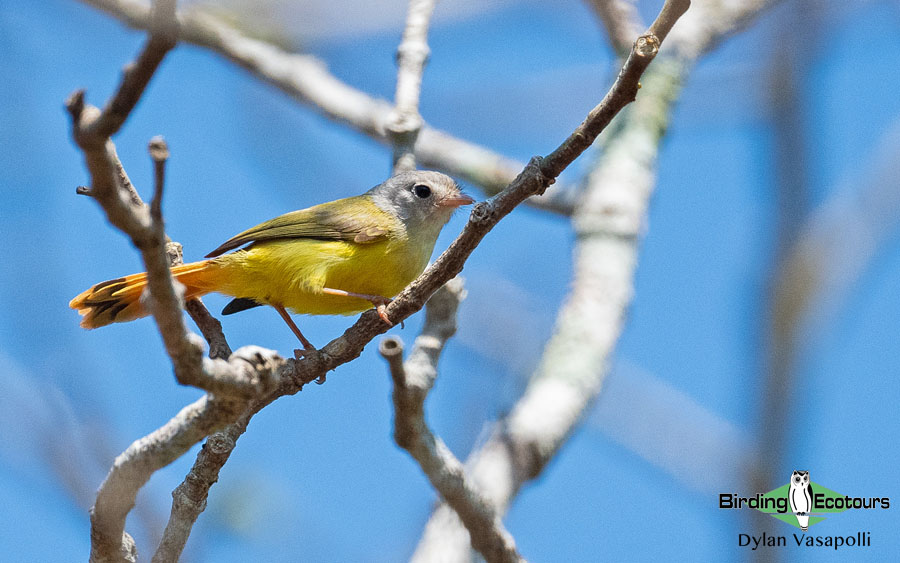
As mentioned, this tour took place during the ongoing Covid-19 pandemic, and despite complicated and altered travel arrangements needed after the end of the tour for some participants to return home (due to the discovery of the Omicron variant of Covid-19, and several airline routes immediately shutting), the actual running of the tour was not impacted, and aside from some minor vehicle issues, the tour went by smoothly. This tour also followed on directly from our Southern Mozambique pre-tour, which had several clients on, with several additional clients joining just for this central Mozambique African Pitta Tour.
The birding itself was largely excellent, and we began proceedings off well in the western highlands. Miombo specials such as African Spotted Creeper, Miombo and Cinnamon-breasted Tits, Miombo Rock Thrush, Western Violet-backed Sunbird and White-breasted Cuckooshrike were all well seen, and were complemented by montane forest species such as Livingstone’s Turaco, Stripe-cheeked Greenbul, Chirinda Apalis, Roberts’s Warbler, White-tailed Crested Flycatcher, Yellow-throated Woodland Warbler and Red-faced Crimsonwing. The mixed woodlands and open floodplains of the Gorongosa National Park followed, where we enjoyed some of Africa’s megafauna such as African Elephant and Hippopotamus, with thousands of antelope, together with a wide selection of birds ranging from Grey Crowned Cranes to African Skimmers to Speckle-throated Woodpeckers, and many in between.
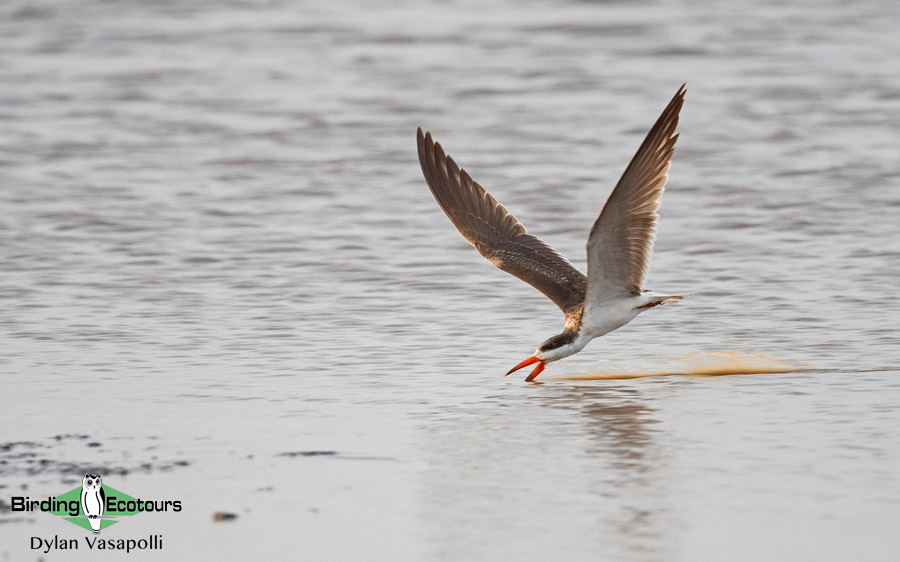
The lowland forests of the Zambezi Delta followed, where we were unsuccessful in our bid to find African Pitta due to the ongoing drought in the area (we have seen this species on all our previous tours from 2014 onwards, so we really were unlucky this year that the rains came late), but came up trumps with many other specials such as Mottled and Böhm’s Spinetail, Chestnut-fronted Helmetshrike, Livingstone’s Flycatcher, Lowland Tiny Greenbul, Black-headed Apalis, East Coast Akalat, reclusive White-chested Alethe and Plain-backed Sunbird to more widespread specials such as Mangrove Kingfisher, Narina Trogon and African Broadbill. A special trip was made to see Böhm’s Bee-eaters on the banks of the Zambezi River. The tour concluded in Beira, where we explored the surrounding seasonally inundated floodplains and surrounds, which turned up such exciting species as Blue Quail, Black-rumped Buttonquail, Great Snipe, Locust Finch and Lesser Seedcracker.
Detailed daily reports, and trip lists can be found below.
Detailed Report
Day 1. 20th November 2021. Arrival, and birding the Rio Savanne floodplains
Some of the group were already in Beira, as a result of joining our Southern Mozambique pre-tour, and therefore had this extra morning available for birding. We had an early start as we went out to explore the nearby Rio Savanne floodplains. Although somewhat inevitable, it was a bit disheartening to see just how much the city and the ever-expanding population has encroached on this area. As expected for this time of the year, the floodplains were dry, and we opted to spend the first part of our morning searching for Lesser Seedcracker. We hunted high and low, but couldn’t find any seedcrackers. We did have various other species around to keep us entertained and enjoyed the likes of Collared Pratincole, Croaking Cisticola, Red-headed Quelea, Magpie Mannikin and Brimstone Canary, amongst others. We had just enough time left to explore some of the fields looking for some of the more exciting specials of the area, such as Blue Quail and Locust Finch. We hit a bit of luck early managing to get a Black-rumped Buttonquail, which showed well, albeit briefly. A wide range of other species were seen throughout our morning, from where we had a midday break, while additional clients joined for this main “African Pitta trip” which was centered in Central Mozambique. A quick afternoon jaunt to some nearby open areas yielded a lovely pair of African Pygmy Geese, numbers of Africa Jacana, and a brief Lesser Jacana, with shorebirds such as Wood and Marsh Sandpiper and Black-winged Stilt, and waterbirds such as Purple Heron, Black-crowned Night Heron and Yellow-billed Stork all showing well. A surprise Grey-headed Kingfisher added some excitement, before we called it a day.
Day 2. 21st November 2021. Birding Rio Savanne floodplains, and transfer to Casa Msika
With the full group in, following further arrivals the previous evening, we set off to bird the Rio Savanne floodplains in the morning. The sky was gloomy, but the weather held for our first walk through the grasslands. We opted to explore a different area from the previous day, which held slightly lusher vegetation, and some water underfoot in places. Here we managed to find a few Black-rumped Buttonquails, and enjoyed good looks, along with some other species such as Quailfinch and Yellow-throated Longclaw. Following a quick coffee and tea break, the sky darkened dramatically and the heavens opened. With heavy rain set in, we made our way back to our Beira guesthouse where we had breakfast and checked out. Some vehicle issues saw us taking a little time to get going once more, but we were eventually back on our way, and made good progress to Casa Msika. Here we would be based for the next four nights as we explored the western highlands of Mozambique, searching for many of the typical Zimbabwe Eastern Highland birds, such as Roberts’s Warbler, Chirinda Apalis, and African Spotted Creeper, amongst others. Following our afternoon arrival, we set off for a walk around the grounds of the lodge, and while it was quiet, did pick up the likes of African Fish Eagle, Willow Warbler, and a brief Bearded Scrub Robin. We settled in for the evening, with exciting days ahead.
Day 3. 22nd November 2021. Birding Mt Tsetserra
We had a full day set aside to explore Mount Tsetserra and surrounds. The road getting there was in bad condition, and took a while to navigate, but we eventually arrived into the patchy miombo woodland on the foothills, and immediately set out. We had a wonderful spell of birding, picking up many species such as African Golden Oriole, White-crested Helmetshrike, Red-faced Crombec and Green-capped Eremomela. A Green-backed Woodpecker left us wanting a bit more, while some of the cleared vegetation produced a flurry of birds with Red-faced and Singing Cisticolas, African Firefinch and a lovely Red-winged Prinia (Warbler). Exploring some of the more mature miombo further along yielded an incredible party of African Spotted Creepers. We spent some time enjoying these secretive birds, and managed great looks, before a White-breasted Cuckooshrike flew in and stole the limelight for a little bit.
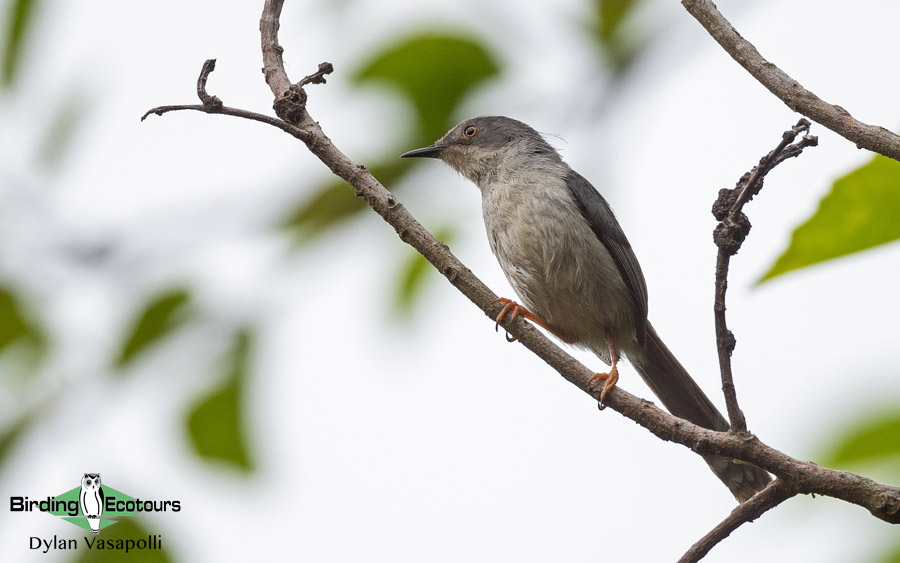
We eventually made our way to the upper reaches of the road, where the montane forest started, and we set off on foot. The cool and overcast conditions persisted and meant that the good birding continued largely unabated. Two of our core targets, Chirinda Apalis and Roberts’s Warblers showed well early on, while Stripe-cheeked Greenbul took a few attempts to track down. A Red-faced Crimsonwing left us wanting a bit more, while calling Livingstone’s Turacos eventually showed. Lively White-tailed Crested Flycatchers and Yellow-throated Woodland Warblers showed well, as did a lovely pair of Black-fronted Bushshrikes. Olive Bushshrike gave us brief views, while a calling Buff-spotted Flufftail frustrated us by remaining out of sight, despite a concerted effort to see it. Eventually we started making our way back down the mountain, and ultimately back to our lodge, with birding stops along the way producing Grey Waxbill and Lesser Honeyguide, amongst others en-route. Our dinner went down well, following an exciting first full day out birding in the area.
Day 4. 23rd November 2021. Birding Chimanimani National Park
We had a full day set aside for birding Chimanimani National Park. This recently proclaimed national park forms a cross-border transfrontier park with the Zimbabwe equivalent, and protects vast tracts of pristine miombo woodland. Indeed, this picturesque park is a major highlight on the tour. Following a long drive from our lodge, and an opportunistic stop en-route for a Gorgeous Bushshrike, we arrived and enjoyed a very productive spell of birding. Miombo birding often requires patience, and as we slowly worked the area, so we notched up the species. Vocal groups of Green-capped Eremomela and Retz’s Helmetshrike were early highlights, as was a Stierling’s Wren-Warbler and White-breasted Cuckooshrike, all of which showed well. The harsh grating calls of a tit led us to a stunning Cinnamon-breasted Tit – one of our major targets of the area. The bird showed very well, and we soaked up our views of this special bird! Another patch of bird activity produced a plethora of species, with Red-faced Crombec, Pale Batis, Southern Hyliota and Black-eared Seedeater all being seen.
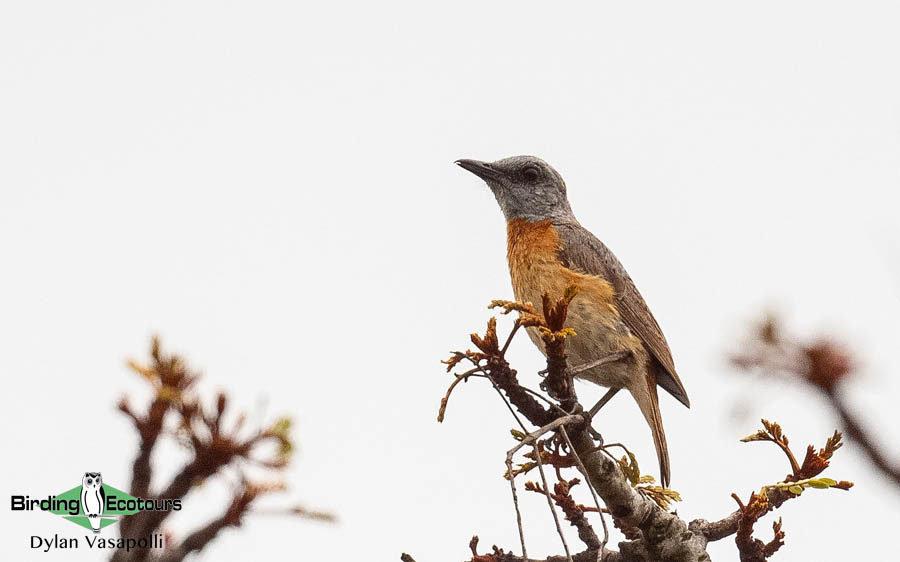
Shortly afterwards, the rain began, and we had to bide our time waiting for it to abate, and as soon as it did, found ourselves in the midst of another bird party. Here numbers of African Spotted Creepers were present, and showed remarkably well, as did the scarce and local Miombo Rock Thrush. More Cinnamon-breasted Tits were located, and we eventually picked up Cabanis’s Bunting in addition to the more common Golden-breasted Bunting. A Yellow-bellied Eremomela was present in the bird party, as were others such as Bearded Woodpecker, Green Wood Hoopoe, Common Scimitarbill and Pale Flycatcher amongst others. Following our lunch break, our final area of birding produced yet more goods, with us once again enjoying such sought-after species as African Spotted Creeper and Cinnamon-breasted Tit, in addition to new species such as Western Violet-backed Sunbird and Wood Pipit. Following a fantastic day out birding the stunning Chimanimani National Park, we began the journey back the lodge, with birding stops en-route producing Levaillant’s Cuckoo, Black-throated Wattle-eye, and a string of raptors with Booted and Wahlberg’s Eagles notable finds.
Day 5. 24th November 2021. Birding Mount Tsetserra and surrounds
We had another full day to explore Mount Tsetserra, where we hoped to clean up on the outstanding species we were still searching for. We started off in the miombo woodlands on the lower slopes, where we slowly worked our way along exploring various bouts of bird activity. Pale Batis and Grey Waxbill were early highlights, as were numbers of African Golden Orioles and African Paradise Flycatchers. It took a little while, but eventually in some of the bird parties we found a single Miombo Tit, which showed very well, and improved on our views of Western Violet-backed Sunbird in the process. A Striped Pipit showed very well for us, and we enjoyed repeat views of Cinnamon-breasted Tit and Retz’s Helmetshrike.
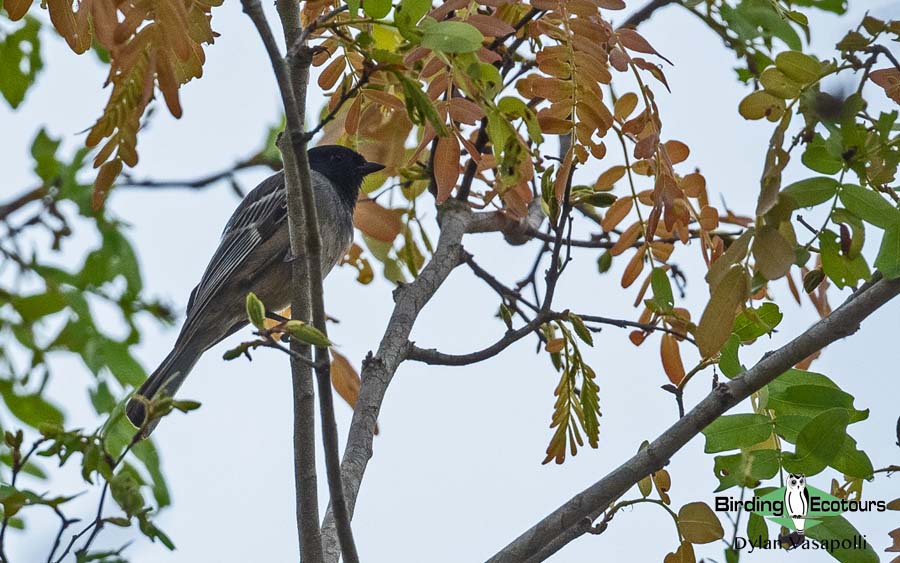
We made our way up to the montane forested areas of the slope and set off for further birding. The birds were quieter today, and we eked out new species such as Cape Robin-Chat, Common Square-tailed Drongo, Olive and Eastern Miombo Sunbirds amongst others, while enjoying some of the specials of the area such as Chirinda Apalis and Stripe-cheeked Greenbul once more. With the sky darkening, thunder rumbling and drizzle starting to fall we beat a hasty retreat. We slowly worked our way back to our lodge, birding along the route, and several birding stops produced some great birds such as Tambourine and Blue-spotted Wood Doves, African Pygmy Kingfisher, Miombo Blue-eared Starling and easily one of our main highlights of the day – a glorious pair of Red-throated Twinspots. After initially hearing the birds calling from some dense undergrowth, we found them a short while later coming down to a puddle to drink and enjoyed completely unobstructed views! We settled in for the evening once we got back to our lodge, following a fantastic time birding in the western highlands of Mozambique!
Day 6. 25th November 2021. Transfer from Casa Msika to Gorongosa National Park
An overcast morning greeted us as we set off on a birding walk around the lodge. Situated within a remnant tract of miombo woodland, we also spent some time exploring the edges of the large Chicamba Dam present here, along with some scrubby thickets on the dam’s edge. We would spend around 3 hours birding and enjoyed lots of activity, with birds present around every bend. A vocal Eastern Nicator gave us some good views after a bit of effort, while various Bearded Scrub Robins stuck to the dark thickets and left us wanting more. A pair of Grey Waxbills foraged on the edge of a thicket, while a pair of Red-throated Twinspots played hide and seek with us, but eventually showed wonderfully! Both Crowned and Trumpeter Hornbills were seen as we went along. Scrubby vegetation on the edge of the dam held the likes of Yellow-bellied Greenbul, Yellow-breasted Apalis, White-browed Scrub Robin, White-browed Robin-Chat, Purple-banded Sunbird, various weavers such as Southern Masked, Village, Spectacled and Holub’s Golden Weavers and some brief views of Magpie Mannikins that left us wanting more. The dam Itself held little of interest, with only African Darter, Striated Heron, Common and Wood Sandpipers, and both Spotted and Water Thick-knees being the only species of interest. Our last sighting, and main highlight of the walk came from a pair of African Cuckoo-Hawks that we heard calling for some time before eventually finding a bird perched up on an exposed branch. We reveled in excellent views, before pulling ourselves away.
Following breakfast, we gathered our things and checked out, bound for the Gorongosa National Park. We had to stop for supplies en-route, as we were self-catering with the park still not functioning at full capacity. We eventually found ourselves on the entrance road to the park, and set off on a short birding walk. Overcast conditions persisted, and meant we had a birdy walk. The scarce Speckle-throated Woodpecker was an early highlight, and was followed up with various species such as Common Cuckoo, Woodland Kingfisher, Greater Honeyguide, Grey-headed Bushshrike and both African and Eurasian Golden Orioles. We enjoyed repeat views of other classic central Mozambique specials such as Pale Batis, White-breasted Cuckooshrike and Red-winged Prinia in the process as well (all of which we had seen already in prior days). Eventually we arrived at the entrance to the Gorongosa National Park, and made our way to Chitengo Camp where we would be based for two nights. The park was still mostly closed, due to Covid, and only the basic park tents were available to stay in. Two very anxious herds of African Elephants were seen on the drive in, along with a host of antelope such as Waterbuck, Nyala and Impala. We settled in for the evening with a lovely braai (which is a South African term for a barbeque), and a vocal pair of African Wood Owls around our camp.
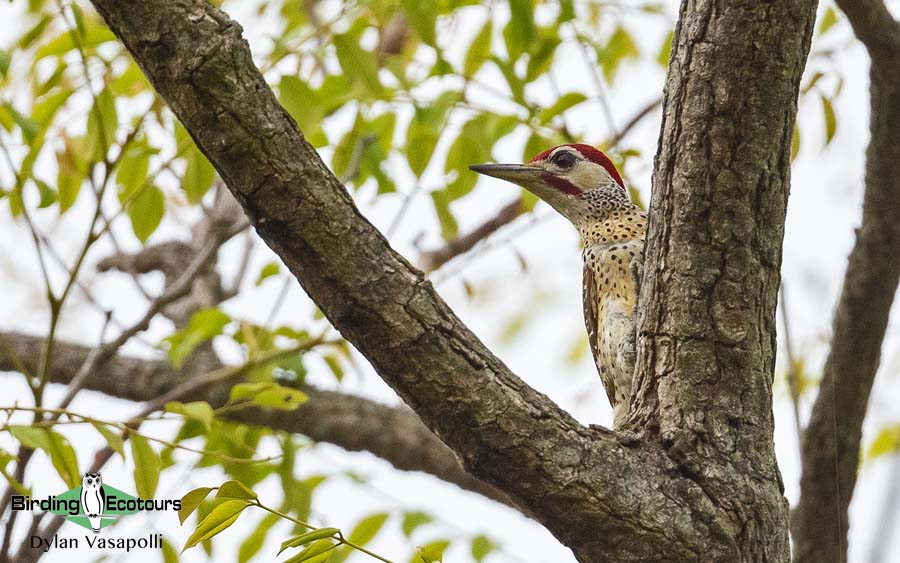
Day 7. 26th November 2021. Birding Gorongosa National Park
Our morning started off early with an action-packed morning drive. We slowly made our way through the mixed woodland, birding our way to the floodplain edge. Birds came in thick and fast, with the likes of Grey-headed Kingfisher, Bearded Woodpecker, Collared Palm Thrush, Brubru, Black Cuckooshrike, Grey Penduline-Tit, Long-tailed Paradise Whydah and Red-headed Weaver being the main highlights. As we moved into the dry, open floodplains reaches, the birds changed and we began adding the likes of Red-necked Spurfowl, Black-bellied Bustard and Senegal Lapwing, while raptors also featured strongly with Hooded, White-backed, White-headed and Lappet-faced Vultures, Black-chested Snake Eagle, Bateleur and Booted Eagle all beginning to move about. The most unusual, and incredible, sighting was a group of four Red-necked Falcons interacting with one another in some high-speed aerial chases! A pair of sought-after Moustached Grass Warblers were picked up in the area as well. Once we reached the edge of the large Urema Lake, our lists increased further with numbers of waterbirds. Stately pairs of Grey Crowned Cranes were sporadically distributed on the edges, whilst the likes of Yellow-billed Stork and African Openbill kept to the actual water, along with numbers of various ducks, herons and egrets. Several Knob-billed Ducks were picked out amongst the larger flocks of White-faced Whistling Ducks, as too were some distant Goliath Herons amongst more widespread heron species. We were also able to add a variety of shorebirds to our tally, including Kittlitz’s Plover, Ruff, Little Stint, Marsh and Wood Sandpipers and Common Greenshank. Birds weren’t our only highlight, and many mammals were seen during our drive as well. Species seen included Yellow Baboon, Blue Monkey, Banded Mongoose, Common Warthog, Hippopotamus, Western Bushbuck, Greater Kudu, Oribi, masses of Waterbuck, (Lichtenstien’s) Hartebeest and Common (Blue) Wildebeest. We eventually returned to camp, where we had some downtime, before going on a late afternoon and evening drive. We were bound for another section of Urema Lake and birded on our way up there, arriving in time for sundowners, which we all thoroughly enjoyed. We also added handsomely to our species tally, with the likes of exciting birds such as Crested Guineafowl, Long-toed Lapwing, Collared Pratincole, a large flock of African Skimmers, Saddle-billed Stork, Great White Pelican, Broad-billed Roller, Green-winged Pytilia and Red-throated Twinspot all being well seen! Our trip back was under the cover of darkness, and we enjoyed an excellent night drive with Square-tailed Nightjar, Water Thick-knee and a lovely Southern White-faced Owl being seen on the birding front, whilst the mammals seen included Cape Porcupine, Thick-tailed Greater Galago, African Civet, Central African Large-spotted Genet and Marsh Mongoose. With a large number of over 130 birds on our daily list, we settled in for the evening, following a very successful day.
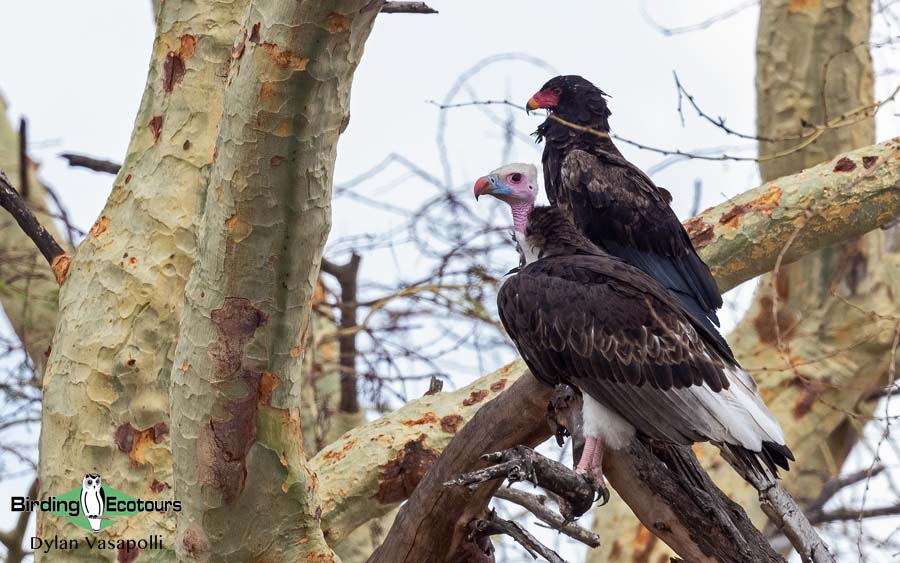
Day 8. 27th November 2021. Transfer from Gorongosa National Park to Catapu
Today was largely set aside as a travel day, not for an immense amount of distance we had to cover, but rather for the very bad state of the roads, which make the going very slow. We had a few hours to bird and explore the mixed woodlands on the entrance road to Gorongosa National Park, outside the park gate. We had a birdy morning, notching up a number of species which included the likes of Shikra, Green Wood Hoopoe, Pale Batis, Retz’s Helmetshrike, White-breasted Cuckooshrike and African Golden Oriole. Soon however, we were off tackling the bad roads to get to our final destination in the Zambezi valley – the lovely Mphingwe Lodge on the Catapu concession, where we would spend the next six nights. Progress was slow, and we were halted even more with some vehicle issues which took some careful ‘bush repairing’ (with thanks to Bruce!), but we were able to press on arriving at camp in the afternoon. Several species were seen in transit, with the most notable being Red-chested Cuckoo, Brown Snake Eagle, Little Bee-eater and Black-winged Red Bishop. Following our arrival, we went on a short afternoon walk through some of the thickets on the concession, which was very quiet, but we were able to pick up on the sought-after Livingstone’s Flycatcher – which showed well to the whole group.
Days 9 – 13. 28th November – 2nd December 2021. Birding the greater Zambezi Delta
The sequence of five full days we were based at Mphingwe Lodge are covered below, as many of the days were spent in the same area with a similar suite of species seen. The core reason for our extended period of time in this area is to allow us enough time to try and track down one of the ‘holy grails’ of African birds – African Pitta. These birds are known from this area, which they visit during a very specific timeframe in the early summer, to breed. This is virtually the only possible period to see these birds, as they display from the area, giving away their presence. Away from their breeding period, they are shy and reclusive, and near impossible to find. Our first morning in the area confirmed our suspicions that the entire area itself was very dry, which didn’t bode well for the pitta. This did indeed prove to be the case, with the entire region devoid of any rain, and as a result, pittas. We spent many hours, over many days patiently birding the area, covering all the usually reliable sites, all without an African Pitta, much to our disappointment.
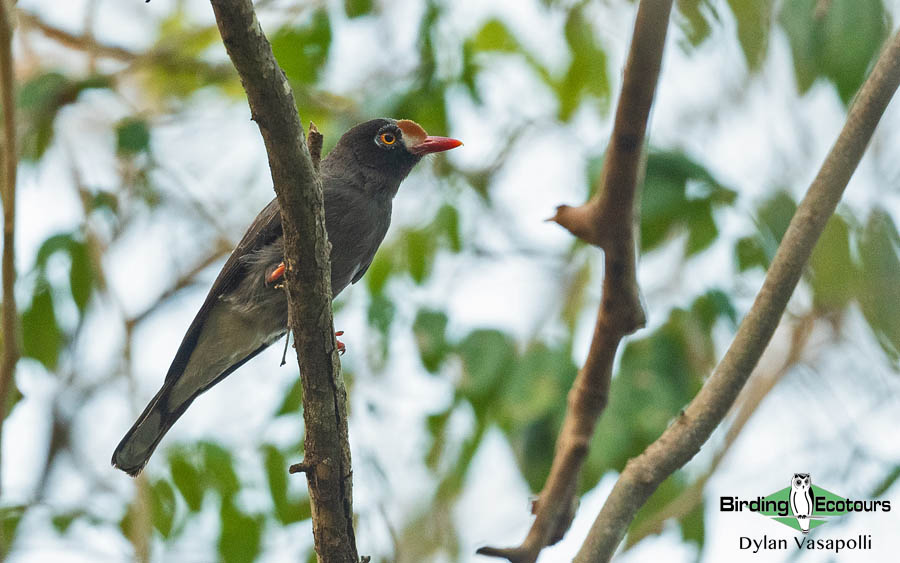
The bulk of our time was spent in the lowland forests that feature here. Many of the specials are shy birds and often require some patience to find. Two of the big culprits in this regard are East Coast Akalat and White-chested Alethe. We were able to pry an East Coast Akalat from its favored thicket and enjoyed great views. White-chested Alethe was far more difficult, calling for extended periods of time, and only offering us the briefest of chances to see it – with not everyone managing to see it. Many of the other specials of the forests were seen on several occasions, and all showed well. Dainty Black-headed Apalis’ moved about in the upper canopy, while the aptly named Lowland Tiny Greenbuls were a regular addition to the soundtrack and were pried out from their thickets on several occasions. Plain-backed Sunbird put up more resistance, but with some patience we were rewarded with great views of this subtly beautiful bird. A loud ‘prrrt’ call gave away a displaying African Broadbill, and we tracked down this incredible bird and spent some time watching the bird display. Groups of curious Chestnut-fronted Helmetshrikes were seen almost daily, while Woodward’s Batis were present around us virtually continuously, with several good looks had. The strange inland population of Mangrove Kingfishers were seen well on occasions, and a major highlight for the group. Although seen previously, Livingstone’s Flycatchers were regularly seen. More widespread species seen here included the likes of Crested Guineafowl, Livingstone’s Turaco, Green Malkoha, African Barred Owlet, Narina Trogon, Scaly-throated Honeyguide, Blue-mantled Crested Flycatcher, Eastern Nicator, Yellow-streaked Greenbul, Black-bellied Starling, Bearded Scrub Robin, Dark-backed Weaver and Green Twinspot (for some).
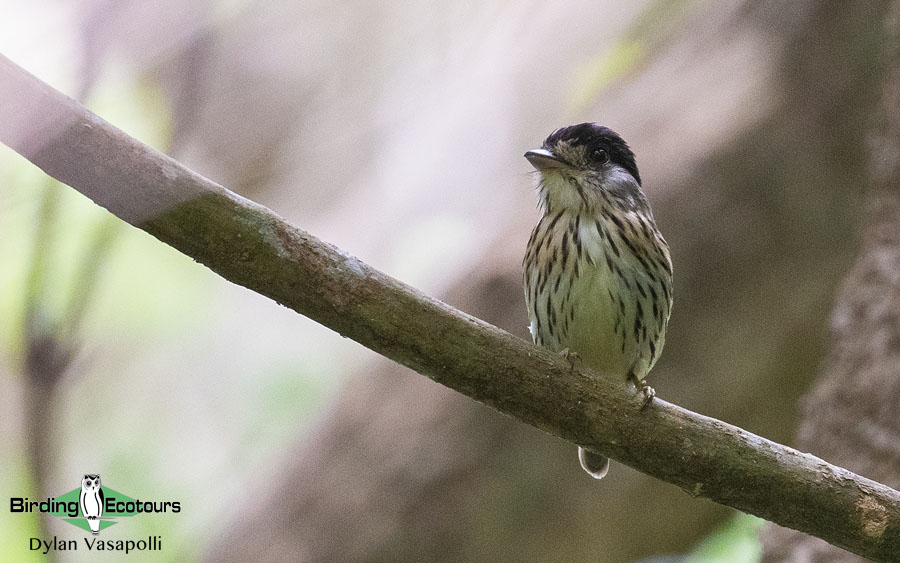
Mature mixed woodland persists outside the forest edges, and these areas were also birded. Flocks of swifts and swallows were searched successfully for both Böhm’s and Mottled Spinetails, and a wide range of raptors were seen moving about – notably; White-headed Vulture, Bateleur, Crowned Eagle, Lizard Buzzard and several vocal Southern Banded Snake Eagles which always remained out of sight frustratingly. Noisy groups of Crowned and Trumpeter Hornbills were regularly seen, as too were numbers of various bee-eaters, with Swallow-tailed, Little, Blue-cheeked, European and Southern Carmine Bee-eaters all featuring. A pair of fast-flying African Hobbies were seen in the early morning hunting over the road, before a pair of the large Brown-necked Parrots gave us a good flyby. A wide array of other species, including various bushshrikes, tchagras, orioles, flycatchers, starlings and sunbirds were all seen in the area as well. We also undertook several night drives through the area, but we were rewarded only with multiple European Nightjars.
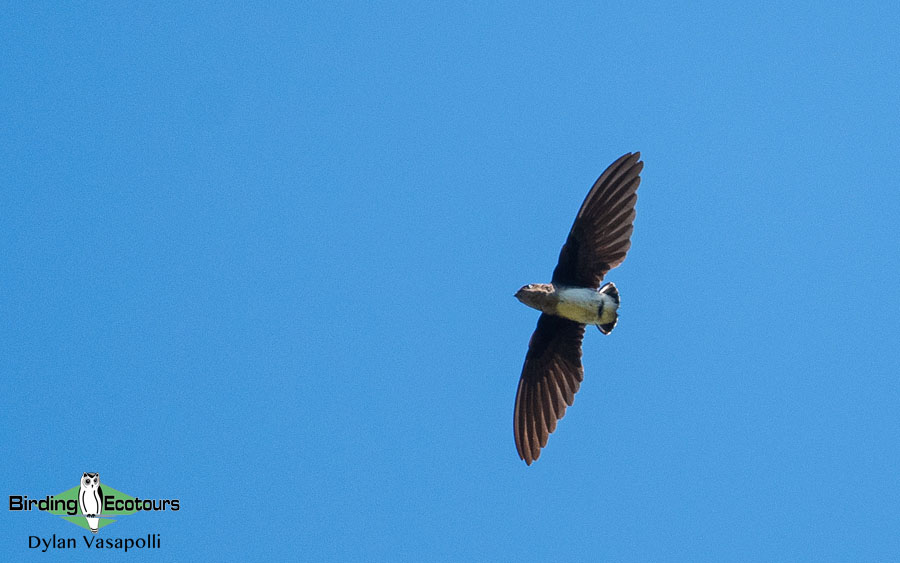
Some time was also spent on the Catapu concession, where a mix of lowland forest and mixed woodland occur, and this yielded exciting species such as Green Malkoha, Mangrove Kingfisher, Narina Trogon, Livingstone’s Flycatcher and a lovely pair of the scarce Orange-winged Pytilia. This area too was barrenly dry, but staking out one of the small pans that had a tiny bit of water continually pumped in produced some of the best views I’ve had of the shy Tambourine Dove, as vast numbers came down to drink, along with several animals such as Suni, Natal Red Duiker, Impala, Nyala and Common Warthog.
A trip up to the Zambezi River at Caia, and further along the Zambezi River was also undertaken to target another of the sought-after specials in the region – Böhm’s Bee-eater. The Zambezi River was as full as I’ve ever seen it, with all the associated pans and floodplains seemingly inundated, which brought with it a host of waterbirds. Numbers of White-faced Whistling Duck and Spur-winged Goose littered the area, while flocks of African Openbill, Reed Cormorants and Glossy and African Sacred Ibises filled the skyline. Paying some careful attention to the waterside vegetation yielded Little Bittern, Black-crowned Night Heron, Squacco and Purple Herons, Great and Little Egrets and African Jacana, amongst others. We were able to find African Reed, Lesser Swamp and Little Rush Warblers in the reeds together with Rufous-winged Cisticola and Southern Brown-throated Weaver, while Moustached Grass Warblers stuck to the bushy edges with the likes of Copper Sunbird and Red-billed Firefinch. Before long we found ourselves further up along the Zambezi River where some more wetland birding yielded Knob-billed Duck, several shorebirds such as Black-winged Stilt, Ruff and Wood Sandpiper, and Black Heron in addition to those we saw earlier in the day. Numbers of Western Yellow Wagtails stalked the edges of wetland, as a group of Orange-breasted Waxbills showed well to us, while some of the surrounding vegetation produced a fine Olive-tree Warbler. It took a little while of searching but we eventually struck gold and found our Böhm’s Bee-eater target in some riverside vegetation. The birds were fairly active, and we spent some time watching them go about their business. Raptors were also out and about, and we enjoyed multiple European Honey Buzzards, still considered a scarce bird in the area, along with African Harrier-Hawk and a lovely Western Banded Snake Eagle amongst others. We were well represented with bee-eaters as well today, notching up six species in total, with White-fronted Bee-eater being the other new addition together with Böhm’s Bee-eater, while our final sighting was of a delightful pair of Brown-headed Parrots perched contently for us.
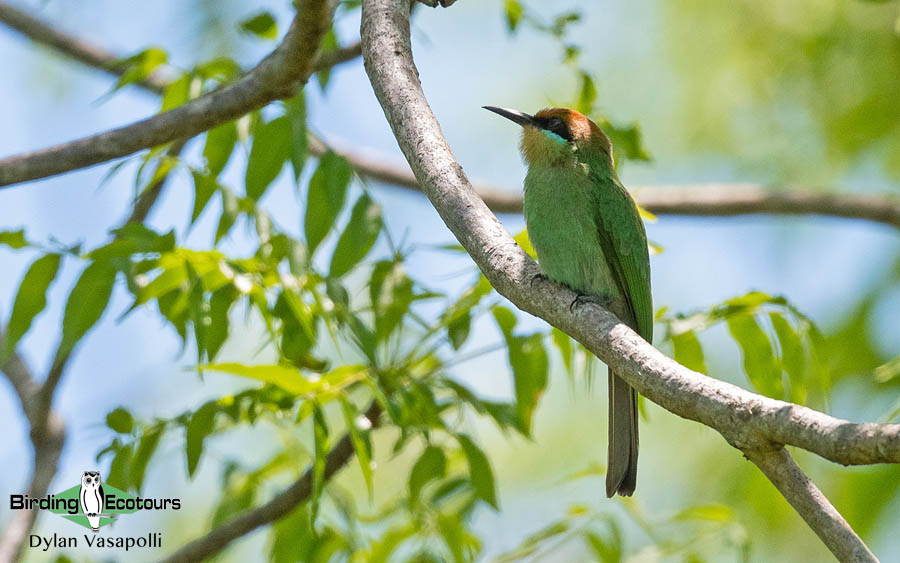
Day 14. 3rd December 2021. Transfer to Beira
We had a long travel day in store, as we transferred from Mphingwe Lodge to the coastal city of Beira, where this tour began. Like many of the roads in central Mozambique, bad roads make for slow travel, and we eventually arrived into Beira in the late afternoon, where we settled in for the evening. A few birding stops en-route allowed us to add Crested Francolin, Jameson’s Firefinch and a group of the nomadic Red-headed Queleas to our trip list, while also enjoying several other stunning birds, such as Woodland Kingfisher, Broad-billed Roller, Southern Carmine Bee-eater and Black-collared Barbet, amongst others.
Day 15. 4th December 2021. Birding the Rio Savanne floodplains
This would have ordinarily been the last day of the tour, but due to various circumstances, meant we would need one more day in the area – with the tour coming to an end tomorrow. This meant we had a full day at our disposal to do some birding in and around Beira and the Rio Savanne floodplains. Our only non-birding requirement was to be back in town at midday to process our Covid tests for our departure. We had several important bird targets for the morning, and the nature of birding this site requires time out walking in the grassy fields. We had an exceptionally successful morning as we explored various areas. Some of the open plains held the likes of Senegal Lawing, Collared Pratincole, Yellow-throated Longclaw and Plain-backed Pipit, while some of the coastal vegetation that line the riverine areas produced species such as Palm-nut Vulture, European Honey Buzzard, White-browed Robin Chat and Copper Sunbird. Walking through the grassy fields was also rewarding turning up several of the rare Great Snipe, a delightful pair of the nomadic Blue Quail, and a very showy pair of sought-after Locust Finches.
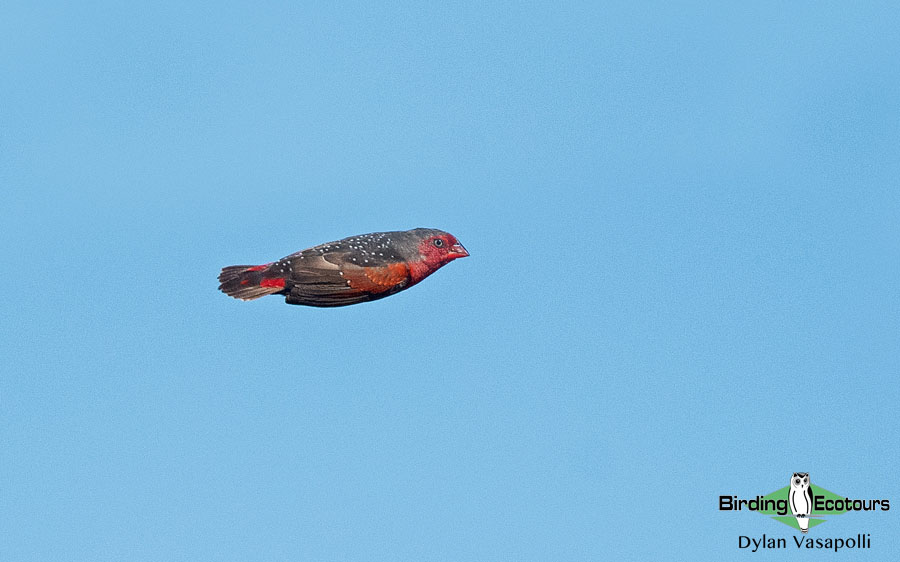
A vast flock of Cuckoo-finches, and a stunning sighting of a Quailfinch pair drinking right in front of us were welcome additions, as too were other species such as African Snipe, Malachite Kingfisher, Flappet Lark, Red-breasted and Mosque Swallows, Croaking Cisticola and Red-backed Mannikin. We had a much-welcomed break over the midday period, and got our Covid tests out the way before spending our afternoon birding around the Rio Maria. The tides were unfortunately against us, but birding around the peripheries of the mudflats netted us almost all of the expected shorebirds. Eurasian Whimbrels dominated the numbers, as too did Common Greenshanks and Curlew Sandpipers, while careful scanning revealed Grey and Common Ringed Plovers, Bar-tailed Godwit, Little Stint and small numbers of the sought-after Terek Sandpiper. Some nearby pans held several pairs of the stunning African Pygmy Goose, which were our last notable sighting before we settled in for our final dinner together.
Day 16. 5th December 2021. Birding Dondo, and departure
This was our last morning of the tour, with the tour concluding at roughly midday. We headed out to a site to try our hand at finding the very difficult Lesser Seedcracker. We arrived in the still cool of the early morning, and as if on cue, picked up on a lovely male Lesser Seedcracker! Our first views were great, but brief before the bird disappeared into some thickets. We repositioned ourselves and were soon watching the bird once more – this time at length! We couldn’t believe our luck and began concentrating on some of the other species present in the area as well. A small group of Little Bee-eaters darted around, while a Marsh Warbler popped out of thicket for some brief views, and flocks of Red-headed Queleas moved quickly through the area. No sooner had we started on the trip back, we ran into one of our outstanding raptors from the trip – Southern Banded Snake Eagle, which we enjoyed excellent views of.
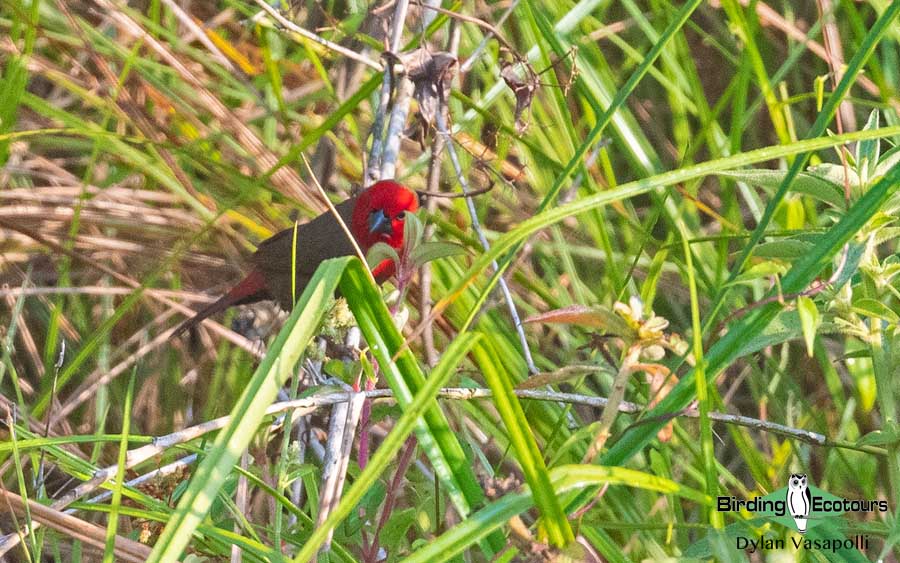
At midday the tour concluded, and we all said our goodbyes, following the end of an exciting and adventurous tour, filled with excellent sightings of many difficult and highly sought-after birds.
While African Pitta unfortunately eluded us, we did remarkably well with seedeaters, enjoying unparalleled sightings of many scarce and usually difficult-to-see species such as Locust Finch, Orange-winged Pytilia, Lesser Seedcracker, Red-throated Twinspot and Red-faced Crimsonwing, amongst others. Our days spent exploring the stunning highlands in Western Mozambique were another firm favorite, with our great spells of miombo birding providing fond memories. Generally speaking, our day within Gorongosa National Park was another major highlight, with vast numbers of birds and mammals keeping us entertained throughout.
Bird List – Following IOC (11.2)
Birds ‘heard only’ are marked with (H) after the common name, birds seen by the ‘guide only; are marked with (G) after the common name, all other species were seen.
The following notation after species names is used to show conservation status following BirdLife International: CR = Critically Endangered, EN = Endangered, VU = Vulnerable.
| Common Name | Scientific Name |
| Ducks, Geese, Swans (Anatidae) | |
| White-faced Whistling Duck | Dendrocygna viduata |
| Spur-winged Goose | Plectropterus gambensis |
| Knob-billed Duck | Sarkidiornis melanotos |
| Egyptian Goose | Alopochen aegyptiaca |
| African Pygmy Goose | Nettapus auritus |
| Guineafowl (Numididae) | |
| Helmeted Guineafowl | Numida meleagris |
| Crested Guineafowl | Guttera pucherani |
| Pheasants & Allies (Phasianidae) | |
| Crested Francolin | Ortygornis sephaena |
| Blue Quail | Synoicus adansonii |
| Red-necked Spurfowl | Pternistis afer |
| Nightjars (Caprimulgidae) | |
| European Nightjar | Caprimulgus europaeus |
| Square-tailed Nightjar | Caprimulgus fossii |
| Swifts (Apodidae) | |
| Mottled Spinetail | Telacanthura ussheri |
| Böhm’s Spinetail | Neafrapus boehmi |
| African Palm Swift | Cypsiurus parvus |
| Common Swift | Apus apus |
| African Black Swift | Apus barbatus |
| Little Swift | Apus affinis |
| White-rumped Swift | Apus caffer |
| Turacos (Musophagidae) | |
| Grey Go-away-bird | Crinifer concolor |
| Purple-crested Turaco | Gallirex porphyreolophus |
| Livingstone’s Turaco | Tauraco livingstonii |
| Bustards (Otididae) | |
| Black-bellied Bustard | Lissotis melanogaster |
| Cuckoos (Cuculidae) | |
| Burchell’s Coucal | Centropus burchellii |
| Green Malkoha | Ceuthmochares australis |
| Levaillant’s Cuckoo | Clamator levaillantii |
| Jacobin Cuckoo | Clamator jacobinus |
| Diederik Cuckoo | Chrysococcyx caprius |
| Klaas’s Cuckoo | Chrysococcyx klaas |
| African Emerald Cuckoo (H) | Chrysococcyx cupreus |
| Black Cuckoo | Cuculus clamosus |
| Red-chested Cuckoo | Cuculus solitarius |
| Common Cuckoo | Cuculus canorus |
| Pigeons, Doves (Columbidae) | |
| Rock Dove | Columba livia |
| Red-eyed Dove | Streptopelia semitorquata |
| Ring-necked Dove | Streptopelia capicola |
| Laughing Dove | Spilopelia senegalensis |
| Emerald-spotted Wood Dove | Turtur chalcospilos |
| Blue-spotted Wood Dove | Turtur afer |
| Tambourine Dove | Turtur tympanistria |
| Namaqua Dove | Oena capensis |
| African Green Pigeon | Treron calvus |
| Flufftails (Sarothruridae) | |
| Buff-spotted Flufftail (H) | Sarothrura elegans |
| Rails, Crakes & Coots (Rallidae) | |
| Black Crake | Zapornia flavirostra |
| Cranes (Gruidae) | |
| Grey Crowned Crane – EN | Balearica regulorum |
| Buttonquail (Turnicidae) | |
| Black-rumped Buttonquail | Turnix nanus |
| Stone-curlews, Thick-knees (Burhinidae) | |
| Water Thick-knee | Burhinus vermiculatus |
| Spotted Thick-knee | Burhinus capensis |
| Stilts, Avocets (Recurvirostridae) | |
| Black-winged Stilt | Himantopus himantopus |
| Plovers (Charadriidae) | |
| Long-toed Lapwing | Vanellus crassirostris |
| Blacksmith Lapwing | Vanellus armatus |
| Senegal Lapwing | Vanellus lugubris |
| African Wattled Lapwing | Vanellus senegallus |
| Grey Plover | Pluvialis squatarola |
| Common Ringed Plover | Charadrius hiaticula |
| Kittlitz’s Plover | Charadrius pecuarius |
| Three-banded Plover | Charadrius tricollaris |
| Jacanas (Jacanidae) | |
| Lesser Jacana | Microparra capensis |
| African Jacana | Actophilornis africanus |
| Sandpipers, Snipes (Scolopacidae) | |
| Eurasian Whimbrel | Numenius phaeopus |
| Bar-tailed Godwit | Limosa lapponica |
| Ruff | Calidris pugnax |
| Curlew Sandpiper | Calidris ferruginea |
| Little Stint | Calidris minuta |
| African Snipe | Gallinago nigripennis |
| Great Snipe | Gallinago media |
| Terek Sandpiper | Xenus cinereus |
| Common Sandpiper | Actitis hypoleucos |
| Marsh Sandpiper | Tringa stagnatilis |
| Wood Sandpiper | Tringa glareola |
| Common Greenshank | Tringa nebularia |
| Coursers, Pratincoles (Glareolidae) | |
| Collared Pratincole | Glareola pratincola |
| Gulls, Terns, Skimmers (Laridae) | |
| African Skimmer | Rynchops flavirostris |
| Storks (Ciconiidae) | |
| Yellow-billed Stork | Mycteria ibis |
| African Openbill | Anastomus lamelligerus |
| Woolly-necked Stork | Ciconia episcopus |
| Saddle-billed Stork | Ephippiorhynchus senegalensis |
| Marabou Stork | Leptoptilos crumenifer |
| Anhingas, Darters (Anhingidae) | |
| African Darter | Anhinga rufa |
| Cormorants, Shags (Phalacrocoracidae) | |
| Reed Cormorant | Microcarbo africanus |
| White-breasted Cormorant | Phalacrocorax lucidus |
| Ibises, Spoonbills (Threskiornithidae) | |
| African Sacred Ibis | Threskiornis aethiopicus |
| Hadada Ibis | Bostrychia hagedash |
| Glossy Ibis | Plegadis falcinellus |
| African Spoonbill | Platalea alba |
| Herons, Bitterns (Ardeidae) | |
| Little Bittern | Ixobrychus minutus |
| Black-crowned Night Heron | Nycticorax nycticorax |
| Striated Heron | Butorides striata |
| Squacco Heron | Ardeola ralloides |
| Rufous-bellied Heron (G) | Ardeola rufiventris |
| Western Cattle Egret | Bubulcus ibis |
| Grey Heron | Ardea cinerea |
| Black-headed Heron | Ardea melanocephala |
| Goliath Heron | Ardea goliath |
| Purple Heron | Ardea purpurea |
| Great Egret | Ardea alba |
| Black Heron | Egretta ardesiaca |
| Little Egret | Egretta garzetta |
| Hamerkop (Scopidae) | |
| Hamerkop | Scopus umbretta |
| Pelicans (Pelecanidae) | |
| Great White Pelican | Pelecanus onocrotalus |
| Kites, Hawks, Eagles (Accipitridae) | |
| Black-winged Kite | Elanus caeruleus |
| African Harrier-Hawk | Polyboroides typus |
| Palm-nut Vulture | Gypohierax angolensis |
| European Honey Buzzard | Pernis apivorus |
| African Cuckoo-Hawk | Aviceda cuculoides |
| Hooded Vulture – CR | Necrosyrtes monachus |
| White-backed Vulture – CR | Gyps africanus |
| White-headed Vulture – CR | Trigonoceps occipitalis |
| Lappet-faced Vulture – EN | Torgos tracheliotos |
| Black-chested Snake Eagle | Circaetus pectoralis |
| Brown Snake Eagle | Circaetus cinereus |
| Southern Banded Snake Eagle | Circaetus fasciolatus |
| Western Banded Snake Eagle | Circaetus cinerascens |
| Bateleur – EN | Terathopius ecaudatus |
| Crowned Eagle | Stephanoaetus coronatus |
| Long-crested Eagle | Lophaetus occipitalis |
| Wahlberg’s Eagle | Hieraaetus wahlbergi |
| Booted Eagle | Hieraaetus pennatus |
| Lizard Buzzard | Kaupifalco monogrammicus |
| African Goshawk | Accipiter tachiro |
| Shikra | Accipiter badius |
| Little Sparrowhawk | Accipiter minullus |
| African Marsh Harrier | Circus ranivorus |
| Yellow-billed Kite | Milvus aegyptius |
| African Fish Eagle | Haliaeetus vocifer |
| Common Buzzard | Buteo buteo |
| Owls (Strigidae) | |
| African Barred Owlet | Glaucidium capense |
| Southern White-faced Owl | Ptilopsis granti |
| African Wood Owl | Strix woodfordii |
| Mousebirds (Coliidae) | |
| Speckled Mousebird | Colius striatus |
| Red-faced Mousebird | Urocolius indicus |
| Trogons (Trogonidae) | |
| Narina Trogon | Apaloderma narina |
| Hoopoes (Upupidae) | |
| African Hoopoe | Upupa africana |
| Wood Hoopoes (Phoeniculidae) | |
| Green Wood Hoopoe | Phoeniculus purpureus |
| Common Scimitarbill | Rhinopomastus cyanomelas |
| Hornbills (Bucerotidae) | |
| Crowned Hornbill | Lophoceros alboterminatus |
| African Grey Hornbill | Lophoceros nasutus |
| Trumpeter Hornbill | Bycanistes bucinator |
| Rollers (Coraciidae) | |
| Lilac-breasted Roller | Coracias caudatus |
| European Roller | Coracias garrulus |
| Broad-billed Roller | Eurystomus glaucurus |
| Kingfishers (Alcedinidae) | |
| Grey-headed Kingfisher | Halcyon leucocephala |
| Brown-hooded Kingfisher | Halcyon albiventris |
| Striped Kingfisher | Halcyon chelicuti |
| Woodland Kingfisher | Halcyon senegalensis |
| Mangrove Kingfisher | Halcyon senegaloides |
| African Pygmy Kingfisher | Ispidina picta |
| Malachite Kingfisher | Corythornis cristatus |
| Giant Kingfisher | Megaceryle maxima |
| Pied Kingfisher | Ceryle rudis |
| Bee-eaters (Meropidae) | |
| Swallow-tailed Bee-eater | Merops hirundineus |
| Little Bee-eater | Merops pusillus |
| White-fronted Bee-eater | Merops bullockoides |
| Böhm’s Bee-eater | Merops boehmi |
| Blue-cheeked Bee-eater | Merops persicus |
| European Bee-eater | Merops apiaster |
| Southern Carmine Bee-eater | Merops nubicoides |
| African Barbets (Lybiidae) | |
| White-eared Barbet | Stactolaema leucotis |
| Yellow-rumped Tinkerbird | Pogoniulus bilineatus |
| Black-collared Barbet | Lybius torquatus |
| Honeyguides (Indicatoridae) | |
| Lesser Honeyguide | Indicator minor |
| Scaly-throated Honeyguide | Indicator variegatus |
| Greater Honeyguide | Indicator indicator |
| Woodpeckers (Picidae) | |
| Speckle-throated Woodpecker | Campethera scriptoricauda |
| Golden-tailed Woodpecker | Campethera abingoni |
| Green-backed Woodpecker | Campethera cailliautii |
| Bearded Woodpecker | Chloropicus namaquus |
| Cardinal Woodpecker | Dendropicos fuscescens |
| Olive Woodpecker (H) | Dendropicos griseocephalus |
| Caracaras, Falcons (Falconidae) | |
| Red-necked Falcon | Falco chicquera |
| African Hobby | Falco cuvierii |
| Lanner Falcon | Falco biarmicus |
| African & New World Parrots (Psittacidae) | |
| Brown-necked Parrot | Poicephalus fuscicollis |
| Brown-headed Parrot | Poicephalus cryptoxanthus |
| African & Green Broadbills (Calyptomenidae) | |
| African Broadbill | Smithornis capensis |
| Wattle-eyes, Batises (Platysteiridae) | |
| Cape Batis | Batis capensis |
| Woodward’s Batis | Batis fratrum |
| Pale Batis | Batis soror |
| Black-throated Wattle-eye | Platysteira peltata |
| Bushshrikes (Malaconotidae) | |
| Grey-headed Bushshrike | Malaconotus blanchoti |
| Black-fronted Bushshrike | Chlorophoneus nigrifrons |
| Olive Bushshrike | Chlorophoneus olivaceus |
| Orange-breasted Bushshrike | Chlorophoneus sulfureopectus |
| Gorgeous Bushshrike | Telophorus viridis |
| Brown-crowned Tchagra | Tchagra australis |
| Black-crowned Tchagra | Tchagra senegalus |
| Black-backed Puffback | Dryoscopus cubla |
| Tropical Boubou | Laniarius major |
| Brubru | Nilaus afer |
| Vangas & Allies (Vangidae) | |
| White-crested Helmetshrike | Prionops plumatus |
| Retz’s Helmetshrike | Prionops retzii |
| Chestnut-fronted Helmetshrike | Prionops scopifrons |
| Cuckooshrikes (Campephagidae) | |
| White-breasted Cuckooshrike | Ceblepyris pectoralis |
| Black Cuckooshrike | Campephaga flava |
| Shrikes (Laniidae) | |
| Red-backed Shrike | Lanius collurio |
| Southern Fiscal | Lanius collaris |
| Figbirds, Orioles, Turnagra (Oriolidae) | |
| Black-headed Oriole | Oriolus larvatus |
| African Golden Oriole | Oriolus auratus |
| Eurasian Golden Oriole | Oriolus oriolus |
| Drongos (Dicruridae) | |
| Fork-tailed Drongo | Dicrurus adsimilis |
| Common Square-tailed Drongo | Dicrurus ludwigii |
| Monarchs (Monarchidae) | |
| Blue-mantled Crested Flycatcher | Trochocercus cyanomelas |
| African Paradise Flycatcher | Terpsiphone viridis |
| Crows, Jays (Corvidae) | |
| House Crow | Corvus splendens |
| Pied Crow | Corvus albus |
| Fairy Flycatchers (Stenostiridae) | |
| White-tailed Crested Flycatcher | Elminia albonotata |
| Tits, Chickadees (Paridae) | |
| Cinnamon-breasted Tit | Melaniparus pallidiventris |
| Miombo Tit | Melaniparus griseiventris |
| Penduline Tits (Remizidae) | |
| Grey Penduline Tit | Anthoscopus caroli |
| Nicators (Nicatoridae) | |
| Eastern Nicator | Nicator gularis |
| Larks (Alaudidae) | |
| Flappet Lark | Mirafra rufocinnamomea |
| Bulbuls (Pycnonotidae) | |
| Sombre Greenbul | Andropadus importunus |
| Yellow-bellied Greenbul | Chlorocichla flaviventris |
| Stripe-cheeked Greenbul | Arizelocichla milanjensis |
| Lowland Tiny Greenbul | Phyllastrephus debilis |
| Terrestrial Brownbul | Phyllastrephus terrestris |
| Yellow-streaked Greenbul | Phyllastrephus flavostriatus |
| Dark-capped Bulbul | Pycnonotus tricolor |
| Swallows, Martins (Hirundinidae) | |
| Black Saw-wing | Psalidoprocne pristoptera |
| Rock Martin | Ptyonoprogne fuligula |
| Wire-tailed Swallow | Hirundo smithii |
| Barn Swallow | Hirundo rustica |
| Common House Martin | Delichon urbicum |
| Red-breasted Swallow | Cecropis semirufa |
| Mosque Swallow | Cecropis senegalensis |
| Lesser Striped Swallow | Cecropis abyssinica |
| Crombecs, African Warblers (Macrosphenidae) | |
| Moustached Grass Warbler | Melocichla mentalis |
| Red-faced Crombec | Sylvietta whytii |
| Long-billed Crombec | Sylvietta rufescens |
| Yellow Flycatchers (Erythrocercidae) | |
| Livingstone’s Flycatcher | Erythrocercus livingstonei |
| Leaf Warblers & Allies (Phylloscopidae) | |
| Willow Warbler | Phylloscopus trochilus |
| Yellow-throated Woodland Warbler | Phylloscopus ruficapilla |
| Reed Warblers & Allies (Acrocephalidae) | |
| Lesser Swamp Warbler | Acrocephalus gracilirostris |
| African Reed Warbler | Acrocephalus baeticatus |
| Marsh Warbler | Acrocephalus palustris |
| Olive-tree Warbler | Hippolais olivetorum |
| Grassbirds & Allies (Locustellidae) | |
| Little Rush Warbler | Bradypterus baboecala |
| Cisticolas & Allies (Cisticolidae) | |
| Red-faced Cisticola | Cisticola erythrops |
| Singing Cisticola | Cisticola cantans |
| Lazy Cisticola | Cisticola aberrans |
| Rattling Cisticola | Cisticola chiniana |
| Rufous-winged Cisticola | Cisticola galactotes |
| Croaking Cisticola | Cisticola natalensis |
| Neddicky | Cisticola fulvicapilla |
| Zitting Cisticola | Cisticola juncidis |
| Tawny-flanked Prinia | Prinia subflava |
| Red-winged Prinia | Prinia erythroptera |
| Roberts’s Warbler | Oreophilais robertsi |
| Bar-throated Apalis | Apalis thoracica |
| Yellow-breasted Apalis | Apalis flavida |
| Black-headed Apalis | Apalis melanocephala |
| Chirinda Apalis | Apalis chirindensis |
| Grey-backed Camaroptera | Camaroptera brevicaudata |
| Stierling’s Wren-Warbler | Calamonastes stierlingi |
| Yellow-bellied Eremomela | Eremomela icteropygialis |
| Green-capped Eremomela | Eremomela scotops |
| Sylviid Babblers (Sylviidae) | |
| Garden Warbler | Sylvia borin |
| White-eyes (Zosteropidae) | |
| Southern Yellow White-eye | Zosterops anderssoni |
| Laughingthrushes & Allies (Leiothrichidae) | |
| Arrow-marked Babbler | Turdoides jardineii |
| Hyliotas (Hyliotidae) | |
| Southern Hyliota | Hyliota australis |
| Treecreepers (Certhiidae) | |
| African Spotted Creeper | Salpornis salvadori |
| Starlings, Rhabdornis (Sturnidae) | |
| Wattled Starling | Creatophora cinerea |
| Black-bellied Starling | Notopholia corusca |
| Miombo Blue-eared Starling | Lamprotornis elisabeth |
| Violet-backed Starling | Cinnyricinclus leucogaster |
| Red-winged Starling | Onychognathus morio |
| Thrushes (Turdidae) | |
| Kurrichane Thrush | Turdus libonyana |
| Chats, Old World Flycatchers (Muscicapidae) | |
| Bearded Scrub Robin | Cercotrichas quadrivirgata |
| White-browed Scrub Robin | Cercotrichas leucophrys |
| Grey Tit-Flycatcher | Myioparus plumbeus |
| Southern Black Flycatcher | Melaenornis pammelaina |
| Pale Flycatcher | Melaenornis pallidus |
| Spotted Flycatcher | Muscicapa striata |
| Ashy Flycatcher | Muscicapa caerulescens |
| African Dusky Flycatcher | Muscicapa adusta |
| White-chested Alethe | Chamaetylas fuelleborni |
| Cape Robin-Chat | Cossypha caffra |
| White-browed Robin-Chat | Cossypha heuglini |
| Red-capped Robin-Chat (H) | Cossypha natalensis |
| White-starred Robin | Pogonocichla stellata |
| East Coast Akalat | Sheppardia gunningi |
| Collared Palm Thrush | Cichladusa arquata |
| Miombo Rock Thrush | Monticola angolensis |
| African Stonechat | Saxicola torquatus |
| Sunbirds (Nectariniidae) | |
| Plain-backed Sunbird | Anthreptes reichenowi |
| Western Violet-backed Sunbird | Anthreptes longuemarei |
| Collared Sunbird | Hedydipna collaris |
| Olive Sunbird | Cyanomitra olivacea |
| Amethyst Sunbird | Chalcomitra amethystina |
| Scarlet-chested Sunbird | Chalcomitra senegalensis |
| Eastern Miombo Sunbird | Cinnyris manoensis |
| Purple-banded Sunbird | Cinnyris bifasciatus |
| Variable Sunbird | Cinnyris venustus |
| Copper Sunbird | Cinnyris cupreus |
| Old World Sparrows, Snowfinches (Passeridae) | |
| Yellow-throated Bush Sparrow | Gymnoris superciliaris |
| Southern Grey-headed Sparrow | Passer diffusus |
| House Sparrow | Passer domesticus |
| Weavers, Widowbirds (Ploceidae) | |
| Thick-billed Weaver | Amblyospiza albifrons |
| Spectacled Weaver | Ploceus ocularis |
| Holub’s Golden Weaver | Ploceus xanthops |
| Southern Brown-throated Weaver | Ploceus xanthopterus |
| Lesser Masked Weaver | Ploceus intermedius |
| Southern Masked Weaver | Ploceus velatus |
| Village Weaver | Ploceus cucullatus |
| Dark-backed Weaver | Ploceus bicolor |
| Red-headed Weaver | Anaplectes rubriceps |
| Red-headed Quelea | Quelea erythrops |
| Red-billed Quelea | Quelea quelea |
| Black-winged Red Bishop | Euplectes hordeaceus |
| Southern Red Bishop | Euplectes orix |
| Yellow Bishop | Euplectes capensis |
| Fan-tailed Widowbird | Euplectes axillaris |
| White-winged Widowbird | Euplectes albonotatus |
| Red-collared Widowbird | Euplectes ardens |
| Waxbills, Munias & Allies (Estrildidae) | |
| Bronze Mannikin | Spermestes cucullata |
| Magpie Mannikin | Spermestes fringilloides |
| Red-backed Mannikin | Spermestes nigriceps |
| Green Twinspot | Mandingoa nitidula |
| Red-faced Crimsonwing | Cryptospiza reichenovii |
| Grey Waxbill | Glaucestrilda perreini |
| Common Waxbill | Estrilda astrild |
| Quailfinch | Ortygospiza atricollis |
| Locust Finch | Paludipasser locustella |
| Orange-breasted Waxbill | Amandava subflava |
| Blue Waxbill | Uraeginthus angolensis |
| Lesser Seedcracker | Pyrenestes minor |
| Green-winged Pytilia | Pytilia melba |
| Orange-winged Pytilia | Pytilia afra |
| Red-throated Twinspot | Hypargos niveoguttatus |
| Red-billed Firefinch | Lagonosticta senegala |
| African Firefinch | Lagonosticta rubricata |
| Jameson’s Firefinch | Lagonosticta rhodopareia |
| Indigobirds, Whydahs (Viduidae) | |
| Village Indigobird | Vidua chalybeata |
| Pin-tailed Whydah | Vidua macroura |
| Long-tailed Paradise Whydah | Vidua paradisaea |
| Cuckoo-finch | Anomalospiza imberbis |
| Wagtails, Pipits (Motacillidae) | |
| Western Yellow Wagtail | Motacilla flava |
| African Pied Wagtail | Motacilla aguimp |
| Yellow-throated Longclaw | Macronyx croceus |
| African Pipit | Anthus cinnamomeus |
| Wood Pipit | Anthus nyassae |
| Plain-backed Pipit | Anthus leucophrys |
| Striped Pipit | Anthus lineiventris |
| Finches, Euphonias (Fringillidae) | |
| Yellow-fronted Canary | Crithagra mozambica |
| Brimstone Canary | Crithagra sulphurata |
| Black-eared Seedeater | Crithagra mennelli |
| Buntings (Emberizidae) | |
| Cinnamon-breasted Bunting | Emberiza tahapisi |
| Golden-breasted Bunting | Emberiza flaviventris |
| Cabanis’s Bunting | Emberiza cabanisi |
| Species Seen | 344 |
| Species heard only | 4 |
| Species seen by guide only | 1 |
| Total species recorded | 349 |
This is a sample trip report. Please email us ([email protected]) for more trip reports from this destination.
